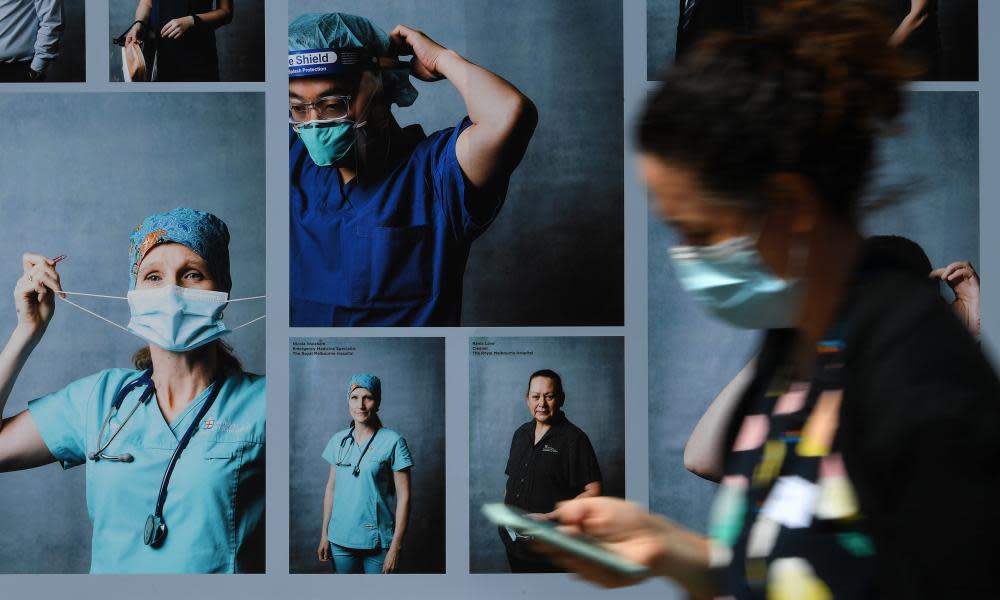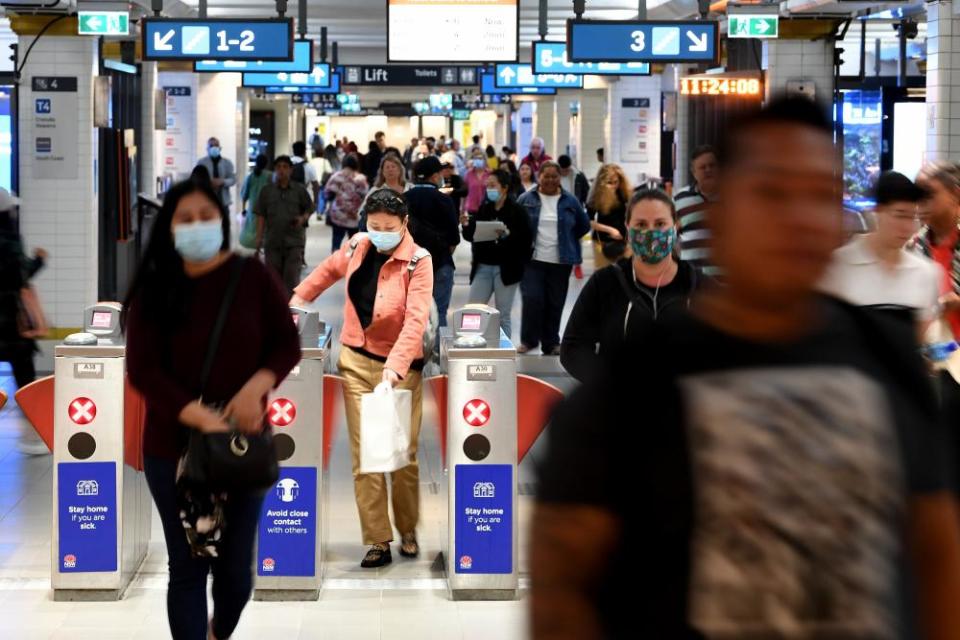Face value: are masks still needed to combat coronavirus in NSW and Victoria?

With double-digit days in a row of no cases of Covid-19 community transmission in Victoria, and several days of no cases in New South Wales, the issue of masks is causing debate.
In Victoria masks are still compulsory throughout the state whenever leaving the home, and being caught without one can incur a $200 fine. In NSW masks are not compulsory but people have been told to consider wearing them in situations where they are unable to maintain a physical distance of 1.5m from others, such as on public transport or in a supermarket. Because it’s not law, compliance is haphazard.
In other states and territories, masks aren’t being pushed as a general public health measure, but those jurisdictions have not grappled with the virus to the same extent. But as the virus appears to have been suppressed throughout the country, some are asking whether masks are are still needed in NSW and Victoria.
What is the evidence for masks?
There is strong evidence from multiple studies that masks can help prevent the spread of Covid, blocking viral particles from entering the nose and mouth, or from landing on surfaces and floating in the air. What is more up for debate is when masks are most effective, and how much they stop the spread in different settings. There are also many different kinds of masks and face-coverings, so efficacy varies depending on the type worn and whether it is worn correctly.
We can transition to a situation where we only wear masks in relatively high-risk situations.
Prof Hassan Vally
It is difficult to do studies on the impact of mask wearing on reducing disease spread in the general population. Studies have been done to examine the efficacy of masks in certain settings, such as in hospitals, on cruise ships and on planes. But it is harder to account for or to control all of the variables when studying the general population, including population density, movement, prevalence of the virus, the type of mask worn and correct mask use. We also still need to learn more about how Covid is transmitted and which size droplets are most responsible for its spread, then consider how effective different types of masks are against these droplets.
A US infectious diseases physician, Dr Monica Ghandi, wrote in the New England Journal of Medicine that even if some masks don’t prevent particles of the virus from entering the nose and mouth entirely, they could reduce the amount of particles that enter in total, reducing disease severity. It is hypothesised that longer exposure to more virus particles results in more severe disease, and more coughing and sneezing leads to more spread. She is analysing hospital admission rates before and after mask mandates in counties across the US to determine whether the severity and rate of disease changed.
Where and when are they most useful?
The World Health Organization’s latest advice, updated in October, says masks are useful in places where the virus is spreading, in which case masks should be worn by the general public where it is not possible to maintain at least a 1m distance from others.
“These settings include indoor locations that are crowded and have poor ventilation, public transport and places of high population density,” the WHO advice states. “In enclosed settings, especially where there is poor ventilation, it is also very important to increase the rate of air change, reduce recirculation of air and increase the use of outdoor air.”
What is the threshold for wearing masks?
An epidemiologist, Prof Hassan Vally, says once the virus has been eliminated in certain areas “wearing a mask is like wearing a hat to protect you from the sun at night” – useless.
The problem is that even though Victoria and NSW have recorded no new community cases for days in a row, this does not mean we can safely say there is no virus lurking in the community, which could take hold again in the right combination of circumstances.
“I am sure some smart mathematician will model this threshold at some point, but in general terms the greater the amount of disease transmission in the population the greater the cost-benefit equation for wearing masks,” Vally said.
“The argument for wearing masks is that they offer a low-cost way to reduce transmission of the virus that doesn’t impact on the economy, and this makes sense. However, I think there is a point where transmission is so low that, at the very least, notwithstanding how inexpensive masks are, that you need to reassess the need to wear masks in all situations … we can transition to a situation where we only wear masks in relatively high-risk situations. That is, those situations where we potentially come into contact with a lot of people indoors, such as grocery shopping and public transport.”

Outdoors is generally considered a low-risk environment due to better ventilation and the ability to socially distance.
What does this mean for masks outdoors?
The UK’s independent Scientific Advisory Group for Emergencies analyses the latest scientific and technical advice to help the government respond to the pandemic. Sage has advised against compulsory outdoor use of masks, even though there have been more than 1.2m confirmed cases in the UK. It classified outdoor mask-wearing as a public health measure that would have “very low impact” on community transmission.
“There are also a number of issues, risks and potentially harmful behaviours associated with recommending or mandating use of face masks which could reduce their effectiveness (eg misuse, use of ineffective homemade masks),” the advice says. “Moreover, it is critical that recommendations are seen to be based on the science and proportionate, otherwise the legitimacy of mask-wearing overall will be compromised. Given that the evidence suggests outdoor spread to be very limited, this may be seen as an excessive measure.”
Are Victoria and NSW right?
A public health physician and an infectious diseases epidemiologist, Assoc Prof Linda Selvey, said with limited transmission occurring, there would not appear to be much benefit in wearing masks.
“On the other hand, as restrictions become less and people have more contact with each other and with more people, then masks can provide some protection should there be transmission occurring in the community that has not yet been detected,” she said.
“I would recommend wearing a mask in situations where there is a lot of mixing – for example, a sports event, concert, Christmas shopping in the CBD, sitting on an aeroplane, attending any mass gathering.”
Victoria requires people to wear masks in restaurants and outdoors, only removing them while eating and drinking. A public health physician and associate professor at the University of Melbourne, Nathan Grills, wrote in the publication Pursuit that “Common sense would indicate this increases risk, not decreases it, potentially contaminating one’s hands and food.”
“As a public health physician I advocated for compulsory masks because they saved lives,” he said. “But things have changed. It’s time for ‘smart masking’. We need to acknowledge that outdoor masks are of little effect and are potentially dangerous, especially for manual labourers, the elderly and in eating areas.”
Should they be mandatory?
The thinking is that by making masks mandatory and applicable in most situations, people will get used to them, and not forget to wear one when transitioning into different environments.
But Vally said if a measure was not proportionate to the level of the hazard, people could grow weary. “I do worry that if masks are mandated to be worn in all situations when the risks of transmission of Covid in the community are marginal, people will start to ignore the directives, and perhaps not wear them in situations that they should,” he said.
New South Wales have shown that tight suppression can be maintained without mandatory masks.
Nathan Grills, University of Melbourne
What is most important is that advice to the public must be clear and easy to follow, Vally said.
“We need to make sure that the reasons for all of the things that we ask people to do are explained clearly and, notwithstanding an abundance of caution and the need to not be too reactive, that we adjust policy settings to match the level of threat in the community,” he said. “I think assuming nothing major happens we should look to adjusting the requirements for mask wearing in Victoria soon.”
Grills says compulsory masks are now excessive. “Why is there a delay in scrapping compulsory masks?” he said. “New South Wales have shown that tight suppression can be maintained without mandatory masks, let alone making people wear masks outdoors.”
‘Wearer fatigue’
Before touching a mask, the WHO says, you should clean your hands with an alcohol-based hand rub or soap and water. You should avoid touching the mask while wearing it and, if you accidentally do touch it, you need to clean your hands and, ideally, change the mask. You also need to clean your mask if it gets dirty or wet, clean your hands before taking off the mask, and wash fabric masks in soap or detergent and hot water at least once a day. That’s difficult to adhere to for hours every day.
“I think that ‘wearer fatigue’ is less likely to occur if people get into the habit of wearing a mask, and if they see others doing so,” Selvey said. “We are a long way from that, however. I also know that, as it is getting hotter, this will make it more difficult to wear a mask as they are hot and can get very uncomfortable. I don’t think there is an easy answer to that.”

 Yahoo News
Yahoo News 
